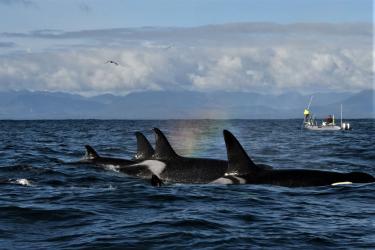This week NOAA Fisheries and our partners will celebrate National Aquaculture Week. NOAA Fisheries and its predecessor agencies have been involved in aquaculture for more than 125 years. We pioneered fish culture methods and stock enhancement techniques to replenish wild stocks. Many culture, hatching, and rearing techniques currently used by the industry worldwide were developed in NOAA labs. That includes the Milford, Connecticut lab for mollusks; the Manchester, Washington, lab for salmon; and the Galveston, Texas lab for shrimp.
Marine aquaculture is an important part of the agency’s strategy for economic and environmental resiliency in coastal communities and supporting healthy oceans. In 2017, U.S. aquaculture producers raised 32 million pounds of salmon, 36 million pounds of oysters, and 9 million pounds of clams along the nation’s coast. In total, farm-raised seafood accounted for 21 percent of the U.S. seafood production by value in 2017. In many fishing and coastal communities around the nation, aquaculture is creating important economic opportunities and year-round employment.
Aquaculture Features
Our Mission: Create New Opportunities for Aquaculture While We Support the Existing Industry
With a growing world population and limited land and freshwater resources, we cannot continue to do business as usual when it comes to our nation’s food security. Farmed seafood is critical for a sustainable seafood portfolio and Aquaculture Week is a yearly reminder of where the industry has been and where we hope to help it go.
Read this leadership message from Director for the NOAA Office of Aquaculture Danielle Blacklock
Aquaculture Supports a Sustainable Earth
A recent UN study shows that aquaculture can improve food security and nutrition. If done correctly, aquaculture increases food production, boosts economic growth in coastal and rural areas, and can help keep waterways clean.
Explore how aquaculture fits into the UN’s sustainability goals
Removing Fish From Fish Diet for Tastier, More Sustainable Aquaculture
NOAA-funded research shows that a diet of poultry meal and algae oil could be just as good for aquaculture fish as fishmeal and fish oil.
Learn more about this NOAA-funded research
Seaweed Aquaculture
Seaweed farming, the fastest-growing aquaculture sector, can benefit farmers, communities, and the environment.
Learn more about seaweed aquaculture
Nine Things You Probably Didn't Know About Aquaculture
Ever wondered how many oysters are farmed in the United States or how much of the global seafood supply comes from aquaculture? Find the answers in NOAA’s Nine Things You Probably Didn’t Know About Aquaculture.
Learn more facts about aquaculture
Aquaculture Videos
Introduction to Ocean Farming Series
NOAA Ocean Today’s series introduces viewers to the different aspects of sustainable ocean farming including oyster farms that benefit restoration efforts, 3D ocean farming for seaweed, and the use of robots for offshore aquaculture.
Watch the Introduction to Ocean Farming Series
Misperceptions About Aquaculture
The public still encounters aquaculture information that is often out of date, incomplete, or inaccurate. In the video below, marine ecologist James Morris addresses the misinformation or bias of marine aquaculture.
Aquaculture Events
Sea Grant Great Lakes Aquaculture Day
The first annual Sea Grant Great Lakes Aquaculture Day will be October 10, 2020. This free, interactive, virtual event will showcase the region’s potential for fish and seafood production and host a culinary competition.
The event is free, open to the public, and registration is required. Activities begin at 8:30 a.m. and end at 4:30 p.m. Central time with a cooking challenge demonstration.









